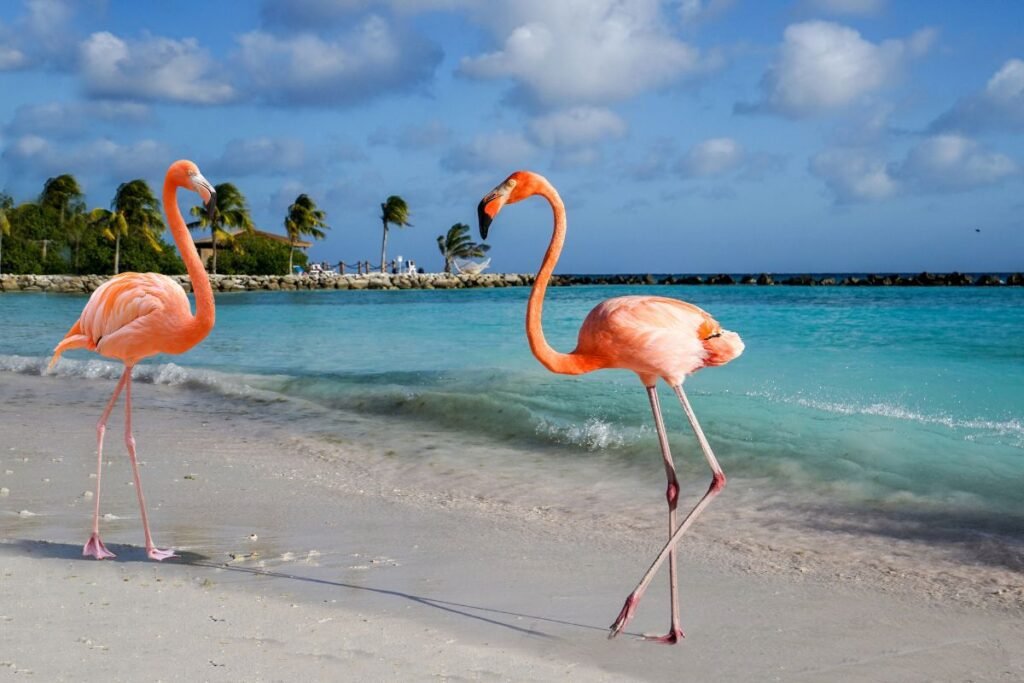Flamingos are undeniably the most recognizable pink birds in the world.
Their vibrant plumage, slender legs, and unique behaviors make them a subject of fascination for bird enthusiasts and nature lovers alike. This article delves into flamingos’ intriguing aspects, habitat, diet, and the reasons behind their striking pink coloration.
Flamingos belong to the family Phoenicopteridae, and there are six species of these captivating birds. These species include the Greater Flamingo, Lesser Flamingo, Chilean Flamingo, Andean Flamingo, James’s Flamingo, and the American Flamingo. They are predominantly found in regions of Africa, the Americas, Asia, and Europe.

Flamingos thrive in large saline or alkaline lakes, estuaries, lagoons, and shallow coastal areas.
These birds prefer environments rich in saline water, which supports the growth of the algae and small crustaceans that constitute their primary diet. Some of the most notable flamingo habitats include the Great Rift Valley in East Africa, the high-altitude lakes of the Andes, and the coastal regions of the Caribbean.
The Secret Behind Their Pink Feathers
One of the most remarkable features of flamingos is their pink plumage. This vibrant coloration is primarily due to their diet. Flamingos consume a large amount of algae and small crustaceans, such as brine shrimp, which are rich in carotenoids. These pigments are broken down in the flamingos’ digestive system and deposited in their feathers, skin, and beaks, resulting in their iconic pink hue. Interestingly, flamingo chicks are born with gray feathers, which gradually turn pink as they mature and start consuming their carotenoid-rich diet.
Flamingos’ unique way of feeding sets them apart from other bird species.
They often feed with their heads upside down, using their specially adapted beaks to filter-feed. The beak is equipped with comb-like structures called lamellae, which help trap and sift through mud and water to capture their food. Flamingos are known to stir up the bottom of shallow waters with their feet to bring food particles to the surface, making it easier to filter out their prey.
Flamingos are highly social birds that live in large colonies, often numbering in the thousands.
These colonies provide protection against predators and create a conducive environment for breeding. The social structure of flamingo colonies is complex, with various displays and vocalizations used to establish hierarchy and strengthen social bonds. During the breeding season, flamingos perform elaborate group courtship displays, which involve synchronized dancing, head-flagging, and wing-saluting to attract mates.
Flamingo breeding seasons vary depending on the species and their geographical location. They typically build their nests out of mud, forming mound-like structures that elevate the eggs above the water level. Each nest usually contains a single egg, which both parents take turns incubating for about 28 to 32 days. Once the chick hatches, it is fed a nutrient-rich secretion known as “crop milk,” both parents produce. This crop milk is essential for the chick’s growth and development during the first few weeks of its life.
Conservation Status
While some flamingo species are classified as least concern by the International Union for Conservation of Nature (IUCN), others face more significant threats. Habitat loss, pollution, and climate change pose serious challenges to flamingo populations. For instance, the Andean Flamingo and the James’s Flamingo are both considered vulnerable due to their limited range and specific habitat requirements. Conservation efforts are crucial to protect these beautiful birds and their habitats, ensuring their survival for future generations to admire.
Fascinating Facts About Flamingos
1. Longevity: Flamingos can live up to 30 years in the wild and even longer in captivity, with some individuals reaching over 50 years of age.
2. Color Variations: The intensity of a flamingo’s pink color can vary significantly depending on its diet and health. Birds with more access to carotenoid-rich food sources display more vibrant plumage
3. Migration: Some flamingo species are known to migrate long distances in search of food and suitable breeding grounds. For example, Lesser Flamingos travel across East Africa to find favorable conditions.
4. Cultural Significance: Flamingos have been symbols of beauty, grace, and elegance in various cultures. They often appear in art, literature, and even as symbols in popular culture.
5. Adaptations: Flamingos have several physical adaptations that allow them to thrive in harsh environments. Their webbed feet help them wade through muddy waters, and their specialized beaks enable efficient filter-feeding.
Conclusion
Flamingos are truly remarkable creatures that captivate our imagination with their stunning appearance and intriguing behaviors. Their vibrant pink feathers, unique feeding techniques, and complex social structures make them one of the most fascinating bird species on the planet. However, it is crucial to address the environmental threats they face to ensure that these iconic birds continue to grace our world with their beauty.
Conservation efforts and increased awareness about the importance of preserving their habitats are essential for the survival of flamingo populations globally. So, the next time you see a flamingo, whether in the wild or at a zoo, take a moment to appreciate the incredible journey that has led to its dazzling pink display.


